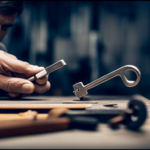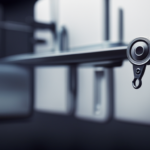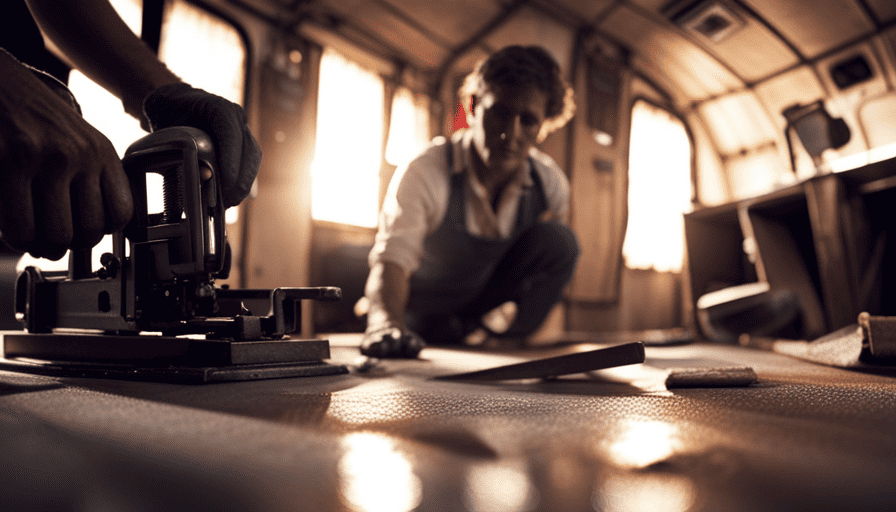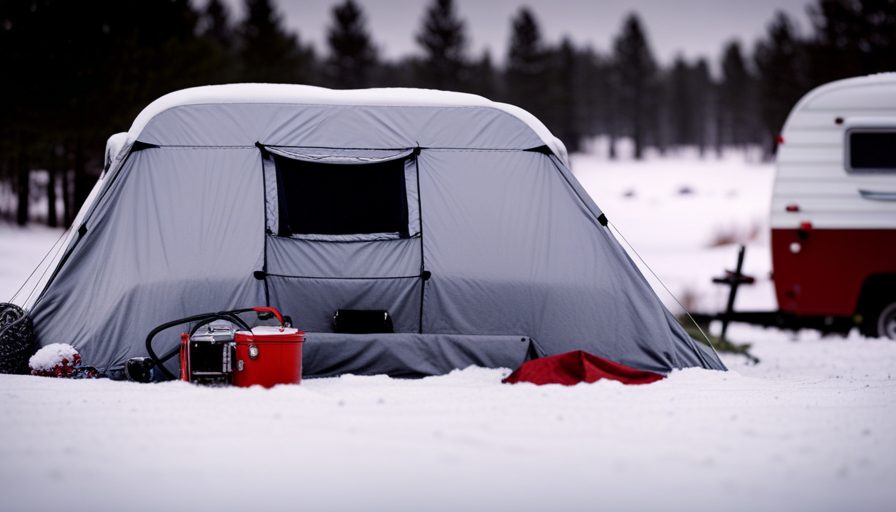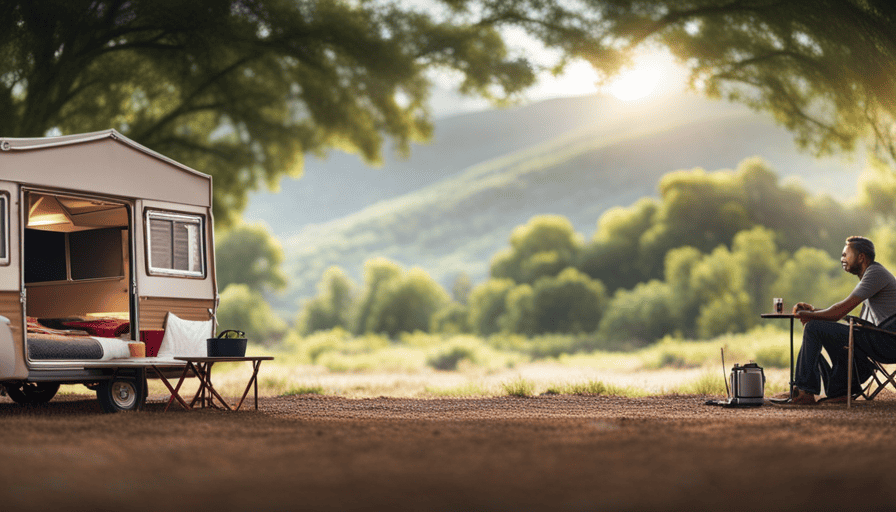Picture this: You are in the midst of a peaceful camping trip, enveloped by the calmness of nature, far away from the chaos of everyday life. It is a perfect getaway, that is until you realize that your camper keys are missing.
Oh, the irony! But fear not, my fellow campers, for I am here to guide you through the process of getting replacement camper keys.
In this article, I will provide you with a step-by-step guide on how to:
- Assess the situation
- Contact the manufacturer
- Visit a local locksmith
- Use key finder devices to prevent future mishaps
I will also emphasize the importance of keeping spare keys in a safe place and considering duplicate keys for added convenience.
So, grab a cup of coffee, sit back, and let’s dive into the world of replacement camper keys. Trust me, you’ll be back to enjoying the great outdoors in no time!
Key Takeaways
- It is important to assess the situation and consider contacting the manufacturer or a local locksmith for replacement camper keys.
- Key finder devices can be helpful in locating lost camper keys, but it is advisable to keep spare keys in a safe place and have duplicates.
- When contacting the manufacturer for replacement keys, provide them with the necessary camper details.
- If the manufacturer does not offer replacement keys, it is recommended to visit a reputable locksmith with experience in working with campers and bring proof of ownership.
Assess the Situation: Determine if you have a spare key or if you need to get a replacement key made.
Take a moment to imagine yourself rummaging through your belongings, desperately hoping to stumble upon a spare camper key. It can be a frustrating experience, especially if you’re in a remote location or need to use your camper urgently. Assessing key replacement options is the first step in resolving this predicament.
Start by checking if you have a spare key. Look in your pockets, bags, and any designated storage compartments in your camper. If you’re lucky, you might find a spare key hidden away. However, if you can’t locate a spare key, you’ll need to get a replacement key made.
Finding lost camper keys can be challenging, but there are several options available. First, contact the manufacturer of your camper to inquire about replacement keys. They’ll likely ask for your camper’s make, model, and vehicle identification number (VIN). This information helps them determine the type of key you need and whether they can provide a replacement.
Assessing the situation and determining if you have a spare key or need to get a replacement key made is crucial. If you can’t find a spare key, contacting the manufacturer is the next logical step to inquire about replacement keys.
Contact the Manufacturer: Reach out to the manufacturer of your camper to inquire about replacement keys.
Contacting the manufacturer of your camper will lead you down a path to unlocking the secrets of accessing a duplicate set of those elusive entry tools. When you reach out to the manufacturer, you can inquire about replacement keys and gather all the necessary information to get a new set. In addition to contacting the manufacturer, you may also want to consider reaching out to a local locksmith who specializes in camper keys.
To help you understand the process better, here’s a table outlining the advantages of contacting the manufacturer versus consulting a local locksmith:
| Contacting the Manufacturer | Consulting a Local Locksmith |
|---|---|
| They have direct access to the key specifications for your camper | They may have experience with a wide range of camper keys |
| They can provide you with the exact replacement key | They may offer a faster turnaround time |
| They may have a record of your camper’s key code on file | They can provide on-site service if necessary |
| They can ensure the key matches your camper’s security system | They may offer competitive pricing |
After considering these options, you can make an informed decision on whether to contact the manufacturer or consult a local locksmith. Remember, when contacting the manufacturer or locksmith, be prepared to provide the make, model, and year of your camper. This information will help them assist you more efficiently in obtaining a replacement key.
Provide Necessary Information: Be prepared to provide the manufacturer with the make, model, and year of your camper.
Make sure you have the make, model, and year of your camper ready when reaching out to the manufacturer or locksmith for a new set of keys. This information is crucial for them to accurately identify the key you need. Before contacting the manufacturer, gather all the necessary details about your camper to ensure a smooth process.
When you reach out to the manufacturer, provide them with the make, model, and year of your camper. This information will help them determine the specific key you require. Additionally, they may ask for your contact information, such as your name and address, to facilitate the delivery of the replacement keys. Being prepared with this information will make the process more efficient and ensure that you receive the correct keys for your camper.
In some cases, the manufacturer may not offer replacement keys. If this is the situation or if you need a quick solution, visiting a local locksmith who specializes in camper keys is a viable option. These locksmiths have the expertise to create new keys for your camper on the spot. They can also provide advice on how to prevent future key-related issues. Remember to bring all necessary documents, such as proof of ownership, to the locksmith to facilitate the process.
Transition: If the manufacturer doesn’t offer replacement keys or if you need a quick solution, visiting a local locksmith who specializes in camper keys can provide you with the assistance you need.
Visit a Local Locksmith: If the manufacturer doesn’t offer replacement keys or if you need a quick solution, visit a local locksmith who specializes in camper keys.
If the manufacturer doesn’t offer replacement keys or if you’re in need of a quick solution, swing by a local locksmith who specializes in camper keys for a swift and convenient fix. Visiting a local locksmith has several benefits:
-
Expertise: Local locksmiths who specialize in camper keys have the knowledge and experience to quickly and accurately create a replacement key for your camper. They understand the specific requirements and intricacies of camper locks, ensuring that the replacement key fits perfectly.
-
Quick Turnaround: Unlike waiting for the manufacturer to send you a replacement key, a local locksmith can provide a solution on the spot. They have the necessary tools and equipment to create a new key right away, saving you time and hassle.
-
Cost-effective: While the cost of replacement keys may vary depending on your camper model and the complexity of the key, local locksmiths often offer competitive pricing compared to the manufacturer. Additionally, you can avoid additional expenses such as shipping fees or waiting for the key to be delivered.
In order to get a replacement key, you may need to provide proof of ownership, such as registration or title documents. This helps ensure that the locksmith is creating a key for the rightful owner of the camper.
Provide Proof of Ownership: In order to get a replacement key, you may need to provide proof of ownership, such as registration or title documents.
To ensure a smooth process, simply bring along your registration or title documents as proof of ownership when visiting the local locksmith specializing in camper keys. These documents are essential to establish that you’re the rightful owner of the camper and that you have the authority to request replacement keys.
The locksmith will need this proof to protect against any potential theft or unauthorized access. When you arrive at the locksmith, explain your situation and request their key replacement services. It’s advisable to choose a reputable locksmith who has experience in working with campers specifically, as they’ll have the necessary expertise and tools to create a replacement key that fits perfectly. You can ask for recommendations from friends, family, or fellow camper owners to find a trustworthy locksmith in your area.
Once you’ve provided the necessary proof of ownership and explained your requirements to the locksmith, they’ll be able to assist you in creating a new key for your camper. They may need to examine the lock or take measurements to ensure an accurate fit. It’s important to follow their instructions and provide any additional information they may need to complete the process smoothly.
Consider a keyless entry system if you frequently lose your keys. It may be worth investing in a keyless entry system for your camper. This system eliminates the need for physical keys and provides added convenience and security.
Consider a Keyless Entry System: If you frequently lose your keys, it may be worth investing in a keyless entry system for your camper.
Enhance your camper’s security and convenience by considering a keyless entry system. This system allows you to effortlessly access your camper without the hassle of physical keys. Keyless entry systems for campers offer several advantages.
Firstly, they provide added security as they use unique codes or fingerprints to grant access, making it difficult for unauthorized individuals to enter your camper. Additionally, keyless entry systems eliminate the need for carrying and potentially losing physical keys. This can be especially beneficial if you frequently misplace or forget your keys.
However, there are also a few drawbacks to consider. Keyless entry systems require power to function, so if the battery dies, you may be locked out of your camper. It’s important to regularly check and replace the batteries to avoid this inconvenience. Additionally, there is a small risk of someone hacking into the system and gaining unauthorized access. To mitigate this risk, it is recommended to choose a reputable and secure keyless entry system.
To maintain and troubleshoot your keyless entry system, follow these tips. Regularly clean the keypad to prevent dirt and debris from interfering with the buttons. If the system malfunctions, check the batteries first, as a low battery can cause issues. If the problem persists, consult the user manual or contact the manufacturer for further assistance.
Transition: In addition to considering a keyless entry system, another useful tool to prevent losing your camper keys is to use a key finder device. Attach a key finder device to your camper keys to easily locate them if they go missing.
Use a Key Finder Device: Attach a key finder device to your camper keys to easily locate them if they go missing.
Make sure you never lose track of your camper keys again by simply attaching a key finder device to them. A key finder device is a small electronic gadget that helps you locate your keys when they go missing. It works by emitting a loud sound or using Bluetooth technology to connect to your smartphone.
Using a key finder device for your camper keys has several benefits. Firstly, it saves you time and frustration by quickly locating your keys when you need them. No more rummaging through drawers or retracing your steps. Additionally, key finder devices can be used for other belongings such as wallets, purses, or even your phone, providing peace of mind for all your valuables.
There are different types of key finder devices available in the market. Some are standalone devices that emit a loud sound when activated, while others use Bluetooth technology to connect to your smartphone. These devices often come with a mobile app that allows you to easily track your keys’ location. Before purchasing a key finder device, consider factors such as range, battery life, and compatibility with your smartphone.
To prevent future key mishaps, make sure to keep spare keys in a safe and easily accessible location. This will ensure that you always have a backup in case your camper keys go missing.
Keep Spare Keys in a Safe Place: To prevent future key mishaps, make sure to keep spare keys in a safe and easily accessible location.
Store your extra set of keys in a secure and convenient spot to avoid any future key mishaps. Safe storage of your spare camper keys is essential for peace of mind and easy access when needed. Here are three key tips to ensure the safety of your spare keys:
-
Choose a hidden location: Find a secure spot that isn’t easily accessible to others, like a locked drawer or a safe. Avoid obvious hiding places like under the doormat or inside the glove compartment.
-
Use a key lockbox: Consider investing in a key lockbox that can be securely attached to your camper. These lockboxes are designed to withstand various weather conditions and provide easy access only to those who know the code.
-
Utilize key replacement services: It’s always a good idea to have a backup plan in case your spare keys are lost or stolen. Research key replacement services that specialize in camper keys and keep their contact information handy.
By storing your extra set of keys in a safe location and utilizing key replacement services, you can be prepared for any unexpected key mishaps. Consider duplicate keys: if you frequently use your camper, it may be helpful to have duplicate keys made and stored in different locations.
Consider Duplicate Keys: If you frequently use your camper, it may be helpful to have duplicate keys made and stored in different locations.
Consider having additional sets of keys made for your camper and strategically placing them in different secure locations to ensure easy access and minimize the risk of being locked out. Duplicate keys for convenience are a smart investment for frequent campers.
By having extra sets of keys, you can avoid the stress and inconvenience of losing or misplacing your only set. It’s important to maintain key organization to ensure that you always know where your spare keys are located.
When deciding on secure locations for your duplicate keys, choose spots that are easily accessible to you but not obvious to others. Some common options include a trusted neighbor’s house, a secure lockbox, or a hidden compartment within your camper itself. By spreading out your spare keys, you decrease the chances of losing all of them at once.
Having duplicate keys and strategically placing them in different locations provides peace of mind, knowing that you have a backup plan if your primary set goes missing. So, before your next camping trip, make sure to double-check that you have your camper keys and any necessary spare keys. This simple step can save you from unnecessary stress and ensure that you can fully enjoy your camping experience.
Plan Ahead: Before your next camping trip, make sure to double-check that you have your camper keys and any necessary spare keys
Don’t forget to double-check that you’ve got your camper keys and any necessary spare keys before your next camping trip. It’s crucial to plan ahead and ensure that you have all the keys you need to access your camper. This simple step can save you from potential headaches and stress during your trip.
Camper key maintenance is an essential aspect of preventing key loss. Regularly inspect your keys for any signs of wear or damage. If you notice any issues, it’s best to get them replaced or repaired promptly. Additionally, consider investing in a keychain or lanyard to keep your keys secure and easily accessible.
Having spare keys is a smart precautionary measure. Make duplicates of your camper keys and store them in different locations. This way, if you misplace or lose your original keys, you’ll have a backup plan. Keep one set of spare keys at home, another in your vehicle, and perhaps even one with a trusted friend or family member.
By following these simple steps, you can ensure that you’re prepared for any unexpected situations regarding your camper keys. Don’t let the frustration of losing or misplacing your keys ruin your camping trip. Take the time to double-check and plan ahead, and you’ll have peace of mind knowing that you have everything you need to enjoy your outdoor adventure.
Frequently Asked Questions
Can I get replacement camper keys from the manufacturer if my camper is no longer under warranty?
Unfortunately, if your camper isn’t under warranty anymore, you may not be able to get replacement keys from the manufacturer. However, you can try reaching out to a reputable third-party locksmith for help. When asking the manufacturer for replacement camper keys, make sure to give them important details like the make, model, and vehicle identification number (VIN). This will help them determine if they can provide the keys or suggest other options.
How long does it typically take to receive replacement camper keys from the manufacturer?
Typically, it takes around 2-3 weeks to receive replacement camper keys from the manufacturer.
To order replacement camper keys, contact the manufacturer’s customer service department and provide them with your camper’s information and any necessary identification or proof of ownership.
To prevent losing your camper keys in the future, consider using a keychain or lanyard to keep them secure and easily accessible. Additionally, you may want to make spare copies and store them in a safe place.
Can I get replacement camper keys made if I don’t have the original key to duplicate?
Yes, it’s possible to get replacement camper keys made even if you don’t have the original key to duplicate. However, the cost of replacement camper keys may vary depending on the make and model of your camper. To find a reputable locksmith for camper keys, you can search online directories or ask for recommendations from fellow campers or RV dealerships. It’s important to choose a locksmith who specializes in camper keys to ensure a proper and accurate replacement.
What should I do if I can’t find a local locksmith who specializes in camper keys?
When facing difficulty finding a locksmith who specializes in camper keys, it’s essential to employ effective strategies to ensure a reliable provider.
Start by seeking recommendations from fellow camper owners or online forums. Additionally, contact local locksmith associations or camper dealerships for referrals.
If unable to find a suitable locksmith, consider alternative options such as contacting the camper manufacturer for assistance or exploring online services that specialize in camper key replacements.
Are there any alternative methods for getting replacement camper keys if I am unable to provide proof of ownership?
If you’re unable to provide proof of ownership, there are alternative methods for obtaining replacement camper keys. One option is to contact the manufacturer of your camper and provide them with any identifying information you have. They may be able to assist you in obtaining replacement keys.
Another option is to hire a professional locksmith who specializes in rekeying campers without the original key. This process involves changing the lock cylinder so that a new key can be used.
It’s important to note that these alternative methods may require additional documentation or fees.
Conclusion
In conclusion, getting replacement camper keys can be a hassle, but with the right steps, it can be a breeze. Here’s what you need to do:
-
Assess the situation and determine if you need to get replacement keys.
-
Contact the manufacturer of your camper and explain the situation.
-
Provide the necessary information, such as the make, model, and VIN number of your camper.
-
If all else fails, visit a local locksmith. Make sure to bring proof of ownership.
To prevent future mishaps, use a key finder device and keep spare keys in a safe place. Planning ahead is always a smart move.
So remember, don’t let lost keys rain on your camping parade. Take action and get yourself back on the road to adventure!



